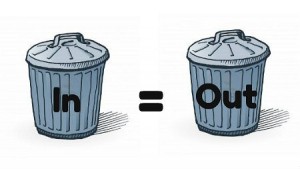 The creative brief may be the domain of the advertising agency, but the power of its inspiration begins with the client, the company doing the advertising.
The creative brief may be the domain of the advertising agency, but the power of its inspiration begins with the client, the company doing the advertising.
The creative brief, after all, is a response to the input the ad agency receives from its client.
If you, as the representative of your company’s branding efforts, choose to spend a serious chunk of your annual budget on advertising, it is in your best interest to make the relationship work. That relationship should start with clearly defined objectives and active participation in the process that leads up to the ad agency’s creative brief.
Follow these five steps and you can assure a firm foundation for every creative brief you ad agency writes.
1. Submit a client brief.
Believe it or not, many clients do not engage in this practice. This is a huge mistake.
I have worked on both the ad agency side and the client side. Some ad agencies in my past did not utilize creative briefs. One client where I worked as the senior executive in charge of advertising also did not have a brief. In both instances, I initiated the practice, sometimes with serious resistance. 
Sometimes it’s called a client brief. I’ve also seen something called a marketing-communications brief (marcom brief for short). If you don’t have either, choose one and institute it right away as part of your best practices.
The client brief is your first opportunity to define expectations in writing. It is your way of saying to your ad agency/creative consultants what, exactly, you expect them to produce. It is very much a contract, a document that sets the tone and the direction. Take it seriously.
Have you heard the phrase, “Garbage in, garbage out”? You know that any effort is worth only as much as you put into it. This is not merely excellent advice. It’s a cautionary tale.
2. Brief your agency partners with this document, and ask both account and creative staff to attend.
Every good relationship depends on communication. This means both clear direction giving and attentive listening. When you ask to brief your agency partners with your client brief on every new project, you are setting not only an example, but also expectations.
Every creative brief you read from your agency is a direct answer to your client brief. It is the agency’s way of saying, “We understand your directions and this is how we have interpreted them.”
If you don’t use a client brief and if you don’t brief your partners with this document, you are leaving yourself wide open for the worst possible outcomes: misinterpretation, misunderstanding, wasted time and wasted money.
3. Insist on being part of the discussion with your agency partners when they begin drafting your creative brief.
Some agency execs may see this as heresy. I say it is vital. It is part of the building blocks of a good, and long-lasting, relationship.
You want to see how your ad agency people interact with each other. You want to hear how they think. They will want to know the same things about you and your team. You have your unique perspective on the products or services you are advertising. If you are honest with yourself, you admit to a skewed and biased point of view. Of course! In the competitive marketplace, you are a partisan.
Your agency people are partisans too, in your corner to help you sell more goods and services.
When you join in this discussion on the first draft of a creative brief, you solidify the place of the brief (yours and the ad agency’s) in the process.
But don’t overstay your welcome. Contribute in the initial phase, and then let your agency people do their jobs. You will see the final outcome in due course, at which time you will have a say.
4. An inspired creative brief may scare you. Remember who the real target is.
The box on the brief that creatives tend to read first is the Single-Minded Proposition (SMP). An inspired SMP is supposed to be very ad-like in its phrasing. It can often sound headline-y. Like a concept or an idea by itself.
I’ve written in this space before that the legendary creative director John Hegarty has often described this line as the first ad for the product. He would write out this line on a blank piece of paper above or below a picture of the product and then tape it to his wall. If it did its job, it was this first ad, the one that ideally would inspire the creatives to create better and better ideas.
Be prepared for something unexpected and often not meant for public consumption. Remember who it is written for: the creative team(s). Not you.
A piece of advice: If the SMP does in fact scare you or make you feel uncomfortable, it’s likely a very good first ad.
This is your cue to smile and sign off on the brief.
5. Participate in the briefing of the creatives.
When you have read and approved the creative brief from you ad agency, ask to be part of the briefing of the creative team or teams assigned to this project. Creatives will have many questions. If you are a veteran of such briefings, you know. If you are new, you will discover both creatives’ curiosity and skepticism as they grapple with realities and challenges on their journey to the idea that becomes the new campaign. 
This is another step in your bonding process with the people who come up with the ideas. Ask them questions! Encourage them to think aloud during this meeting. Ferret out their thinking, their concerns, their ingenuity…their uninhibited joy in the creative process.
The creative brief, as I have said many times, is the first step in the creative process. It is the document bemoaned and disdained and, when it is done well, heralded.
But we forget that the creative brief does not exist in a vacuum. It is a response to whatever input the agency received from its client.
If you end up not liking the ideas your agency presents, ask yourself if you did your job up front with a clear client brief.


